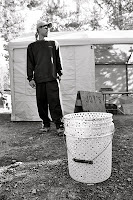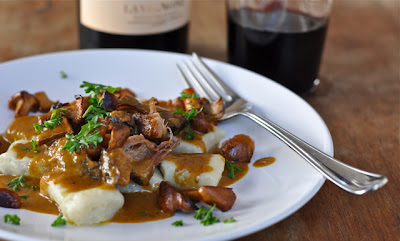This past weekend I traveled down to Oregon with photographer Eirik Johnson (check out his work here) to pitch my tent at a matsutake camp in the Central Cascades of Oregon, on the edge of the high windblown desert. (More on the unlikely setting later.)
We stayed at the smaller camp in the woods near Crescent Lake, where a mushroom buyer named Joy was kind enough to give us space behind his buy station. That night pickers trickled back into camp to sell their day’s work to Joy, who was paying 20/20—twenty dollars a pound for both #1 and #2 matsutake buttons. The former (pictured at top) has an intact veil covering the gills—the preference of well-heeled customers in Japan, where these mushrooms were destined—while the latter is slightly marred by a small hole in the veil, as shown (barely) below if you click on the image. In any event, both grades fetch the same price in a year such as this, when the picking is poor and mushrooms are in demand.

That night we hung out by the fire with a couple pickers from Weed, California. Som, Laotian by birth, first started picking matsutake in the Crescent Lake area as a teenager with his mother. He’d been in camp since the highly regulated season opened after Labor Day. His dog Whiskey guarded the shelter by day.
Som’s friend Forrest, pictured below with his day’s pay, was picking for the first time since his usual construction work has dwindled. He told us the learning curve was steep—something we would learn firsthand the next day when we went picking with Joy and his kids.
Sometime after dark a refrigerated truck stopped at the buy station to collect 260 pounds of matsutake and drive it to Portland where it would be processed (cleaned and packed) and air-freighted to Japan so that the matsutake-crazed customers of that small island nation could shop for inividually-wrapped buttons at the market. Last year the nightly poundage at Joy’s station might have been five times more.
I’ve picked plenty of matsutake in the past closer to home, which I usually cook in a traditional Japanese-style sukiyaki. But here on the edge of the desert the picking is entirely different. Whereas I look for mature fir trees in the North Cascades, most of the picking at Crescent Lake is in pine: lodgepole and ponderosa, with a smattering of Douglas-fir and true firs. In some cases the tree composition is all pine and the conditions surprisingly dry.
Matsutake, however, thrive in sandy soils, and the pumice-laden soil in this volcanically active area provides ideal habitat. Mount Mazama‘s eruption nearly 7,700 years ago created Crater Lake and dumped three to five feet of pumice on the surrounding hills. Though the ground appears dry and dusty, the pine needle duff holds enough moisture to promote great fruitings. Joy said that Japanese customers appreciate the chewy texture of high desert Oregon matsutake.

Picking matsutake in the pine forests around Lake Crescent on a year such as this, when the pick is small, is not for beginners like Forrest (though he was fortunate to have an expert mentor in Som). In a normal year a matsutake patch will announce itself with “flags” or “flowers”—fully emerged mushrooms that indicate the presence of smaller buttons hiding under the duff. This year even the #6 flowers were commanding a decent price, meaning everything was getting picked. And experienced pickers who knew how to find the concealed buttons were being careful to “control” their patches, as a buyer named Leo explained to me, by picking everything to eliminate any evidence of fruiting mushrooms and then visiting regularly to catch the buttons before they emerged.

Finding a matsutake button beneath the duff on a forest floor otherwise devoid of any sign of fungi, indeed a floor without a single mushroom anywhere in sight, is an art form. Joy showed us how it was done. He carefully scanned the ground of a known patch before pausing over what to me was an imperceptible rise in the duff. Using a metal staff that resembled a tire iron, he scraped away a small amount of forest debris to reveal the white cap of a matsutake button. He picked it stem and all without trimming anything (Japanese customers want the dirt attached at the end, as this signifies life force). Later, when I tried to find matsutake on my own in a stretch of woods filled with pickers, I got completely blanked.
Unlike Joy, Som, and Forrest, who prefer camping in the woods, most of the pickers and buyers are now based out of the town of Chemult, 20 miles down the road from Crescent Junction, where several business owners in town rent space for mushroom camps. Pickers and buyers have moved here in recent years to avoid onerous fees levied first by the Forest Service and now Hoodoo, a private concessionairre. Hoodoo has since cut its prices, but it may be too late to lure the pickers away from the comforts of town, which include electricity and nearby groceries.
Margins are thin in the wild mushroom trade and costs can be shaved in other interesting ways. One buyer in Chemult operated out of a shipping container.
We were lucky enough to visit the night of a big celebration in support of a Buddhist temple in Springfield, Oregon, where many of the Southeast Asian pickers live. Lao, Hmong, Mien, and Cambodian pickers celebrated by slaughtering a cow and then feasting on a dinner of beef tripe soup, beef larb, sticky rice, and barbecued ribs. A Laotian pop star stopped by en route during a U.S. concert tour to entertain. Even Buddhist monks were on hand to offer blessings.
Much has been said about the Wild West nature of the Crescent Lake and Chemult matsutake scene. Indeed, I heard many stories around the fire, stories for another time. Suffice it to say that I was impressed by the skill of the pickers and the sense of community that attends this unusual stop on the mushroom trail.
Like this:
Like Loading...




































